Sharpnose Sevengill Shark
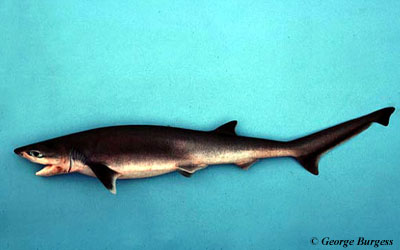
Heptranchias perlo
Unlike most sharks, it has seven instead of five pairs of gill slits (Last and Stevens 2009). Because it is small and lives in deep waters, it is considered no threat to humans, but when caught it can be aggressive, and the flesh is potentially poisonous (Halstead and Campbell 1990).
Order – Hexanchiformes
Family – Hexanchidae
Genus – Heptranchias
Species – perlo
Common Names
- English: Sharpnose sevengill shark, One-finned shark, Perlon shark, Sevengill cow shark, Sevengilled Mediterranean shark, Sevengilled shark, Sharpnose seven-gill shark, Snouted sevengill shark, Slender sevengill shark
- Arabic: Kalb
- Finnish: Kapeapäähai
- French: Chien de mer
- German: Aschfarbener Siebenspalthai, Perlon, Kammzähner, Siebenkiemiger kammzähner
- Greek: Aletre Eftakarcharias
- Italian: Angiolo
- Japanese: Edo-aburazame
- Korean: Kko-ri-gi-rum-sang-o
- Mandarin: Jian wen qi sai shi
- Portuguese: Albafar bravo, Archote, Bico doce, Cação, Tubarão-de-sete-guelras. Olho-branco
- Spanish, Alcatriña, Bocadul, Bocadulce, Cañabota bocadulce
Importance to Humans
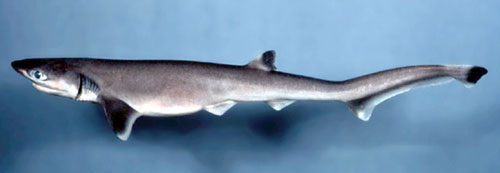
Although of only minor commercial fishery interest, this shark is caught primarily as bycatch in fisheries using bottom trawls and longlines (Braccini 2008). In waters off North America, it occurs in such low numbers that it is of no economic importance (Compagno and Smale 1989).
Danger to Humans
This shark is considered harmless to humans. However, care must be taken when landing this shark as it is aggressive and will attempt to bite its captors (Compagno 2001). The flesh is mildly poisonous to humans when consumed (Halstead and Campbell 1990).
Conservation
Although the the true population size of this species is unknown the ICUN has listed it as Near Treatened due to decreased landings. This is likely due to bycatch in bottom trawls and longline fisheries.
> Check the status of the sharpnose sevengill shark at the IUCN website.
The IUCN is a global union of states, governmental agencies, and non-governmental organizations in a partnership that assesses the conservation status of species.
Geographical Distribution
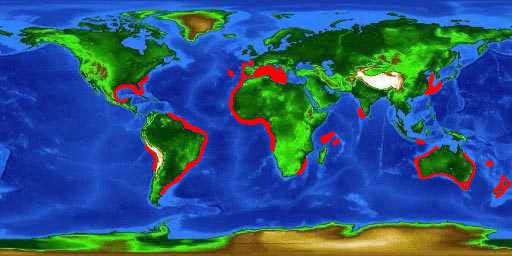
Distributed in tropical and temperate regions, the range of the sharpnose sevengill shark is almost circumglobal with the exception of the northeast Pacific Ocean. In the western Atlantic Ocean, this shark is distributed from North Carolina (U.S.) and northern Gulf of Mexico to Cuba and from Venezuela south to Argentina, and in the eastern Atlantic from Morocco to Namibia, including the Mediterranean Sea. It’s also found in the Indian Ocean in waters off southwestern India, Aldabra Island, southern Mozambique, and South Africa. Distribution in the Pacific Ocean occurs from Japan to China, Indonesia, Australia, and New Zealand as well as off the coast of northern Chile (Compagno 2001).
Habitat
As a deepwater species, the sharpnose sevengill lives in waters on outer continental and insular shelves at depths from 27-1000 m (89-3,280 feet) (Castro 1999). It is usually found on or near the bottom, although on occasion it is observed close to the surface (Castro 1999). Its wide distribution range suggests that the sevengill shark is probably a strong swimmer.
Distinguishing Characteristics
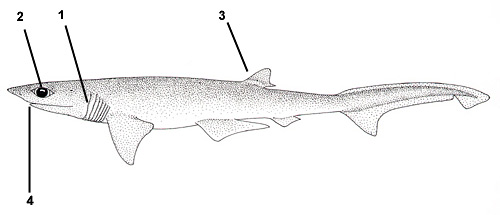
1. Seven gill slits
2. Eye is green in life
3. Single dorsal fin
4. The teeth in the lower jaw are broad and comb-shaped
Biology
Distinctive Features
This moderately small shark has a slender, fusiform body with a narrow, pointed head, large green eyes, and a long narrow mouth.
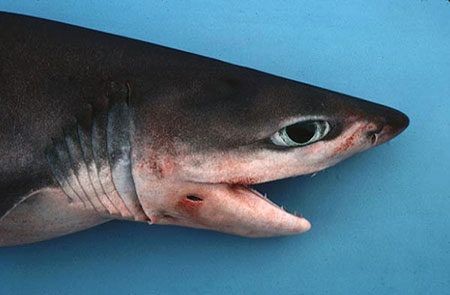
It has seven pairs of gill slits in contrast to the five gills that most sharks possess. These gill opening extend down onto the throat. There is only one small dorsal fin which originates over the inner margins of the pelvic fins. The front edge of the dorsal fin is either straight or slightly convex while the apex is rounded and rear edge concave. The anal fin is also small in size with nearly straight edges, originating under the posterior end of the base of the dorsal. The pectoral fin is small with a weakly convex outer margin and narrowly rounded apex. The caudal axis is just slightly raised with a convex upper margin and a subterminal notch on the lower margin. (Compagno 2001)
The sharpnose sevengill shark may be confused with the broadnose sevengill shark(Notorynchus cepedianus). The broadnose sevengill has small eyes and a broad, rounded snout in contrast to the large eyes and narrow and pointed snout of the sharpnose sevengill. The broadnose sevengill also has black spots over its entire body in contrast to the sharpnose sevengill that lacks this coloration. (Compagno 2001)
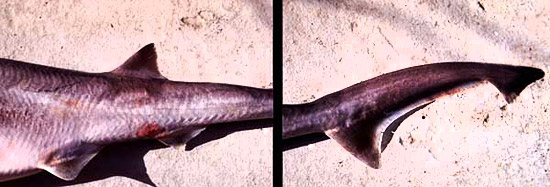
Coloration
Brownish grey to olive on the dorsal surface, paling to a lighter ventral surface. Adults may have indistinct pale posterior margins on all fins as well as faint dark blotches on the body (Compagno 2001). Live specimens have large fluorescent green eyes. Juveniles may have dark blotches in the flank area as well as dark tips on the dorsal and caudal fins (Last and Stevens 2009).
Dentition
The first 3 or 4 teeth in the upper jaw are narrow with a hook-like cusp and small lateral cusps. The subsequent teeth have one or two small cusps. The teeth in the lower jaw are broad and comb-shaped with the exception of a small symmetrical tooth located at the symphysis. There are 9-11 teeth on each side of the upper jaw and 5 teeth on each side of the symphysial tooth on the lower jaw. (Last and Stevens 2009, Braccini 2008)
Denticles
The dermal denticles overlap closely. Each denticle is longer than broad with a larger median tooth followed by a pair of smaller lateral teeth. The median ridge is distinct. The denticles are very thin and transparent, allowing the pigmentation of the skin to be visible. The denticles along the upper edge of the caudal fin are ovoid and lack marginal teeth. Three longitudinal ridges are present, forming a poorly defined crest.
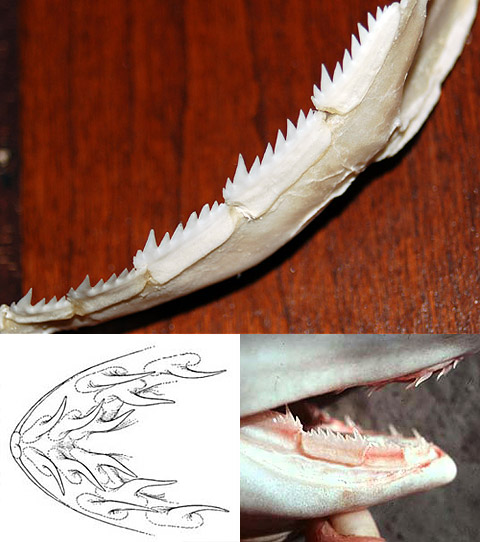
Size, Age, and Growth
Being the smallest hexanchoid shark, it only grows to a maximum length of 1.37 m (4.5 feet) total length for males and 1.40 m (4.6 feet) total length for females. However, this species is more commonly observed at lengths of 0.6-1.2 m (2-4 feet). Males reach maturity at 0.75-0.85 m (2.4-2.8 feet) total length and females reach maturity at slightly larger sizes of 0.9-1.0 m (3.0-3.3 feet) total length. Biologists have observed formation of mucus on the tips of the claspers on mature and subadult males. It is believed this indicates the onset of maturity and perhaps sexual activity. (White et. Al 2006).
Food Habits
Although this shark is rather small in size, it is a voracious predator. As a generalist, it feeds on marine invertebrates including shrimp, crabs, lobsters, squid and cuttlefish as well as small bony fish, such as hake, and small sharks and rays (Braccini 2008). Feeding and activity increases during night time hours (Braccini 2008).
Reproduction
An ovoviviparous species with no apparent set reproductive season. Following gestation, from 9-20 pups are born in each litter. Each newborn pup measures approximately 0.25 m (0.8 feet) in length. (Compagno 2001)
Predators
Larger sharks
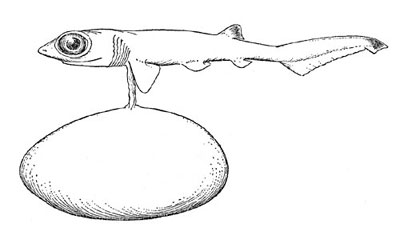
Parasites
Nematodes including Anisakis sp. and Contracaecum sp. are documented parasites of this shark. Other species of nematodes have been reported from the stomach mucus of the sharpnose sevengill (Henderson and Williams 2001). Crossobothrium dohrnii, is among the many parasitic cestodes found in the intestine of this species.
Taxonomy
The sharpnose sevengill shark was described as Heptranchias perlo by Bonnaterre in 1788. The genus nameHeptranchias is derived from the Greek “heptra” meaning seven arms and “agchein” meaning throttle. Synonyms used in past scientific literature to refer to this species include Heptranchias cinereus Gmelin 1789, Squalus cinereus Gmelin 1789, Notidanus cinereus Gmelin 1789, Heptrancus angio Costa 1857, Heptranchias angio Costa 1857, Notidanus cinereus aetatis Bellotti 1878, Notidanus cinereus pristiurus Bellotti 1878, Heptranchias deani Jordan & Starks 1901, and Heptranchias dakini Whitley 1931.
Prepared by: Cathy Bester
Revised by: Tyler Bowling and Nava Kiss 2019
References:
- Braccini, J.M., 2008. Feeding ecology of two high-order predators from south-eastern Australia: the coastal broadnose and the deepwater sharpnose sevengill sharks. Marine Ecology Progress Series, 371, pp.273-284.
- Castro, J.I., Woodley, C.M. and Brudek, R.L., 1999. A preliminary evaluation of the status of shark species (No. 380). Food & Agriculture Org..
- Compagno, L.J., 2001. Sharks of the world: an annotated and illustrated catalogue of shark species known to date (Vol. 1). Food & Agriculture Org..
- Compagno, L.J., Ebert, D.A. and Smale, M.J., 1989. Guide to the sharks and rays of southern Africa.
- Halstead, B.W., Auerbach, P.S. and Campbell, D.R., 1990. A colour atlas of dangerous marine animals. Wolfe Medical Publications.
- Henderson, A.C. and Williams, R.S., 2001. A new record of the sharpnose seven-gill shark Heptranchias perlo, from the north-east Atlantic. Journal of the Marine Biological Association of the United Kingdom, 81(4), pp.707-708.
- Last, P.R. and Stevens, J.D., 2009. Sharks and rays of Australia.
- White, W.T., Last, P.R., Stevens, J.D. and Yearsley, G.K., 2006. Economically important sharks & rays of Indonesia. Australian Centre for International Agricultural Research (ACIAR).